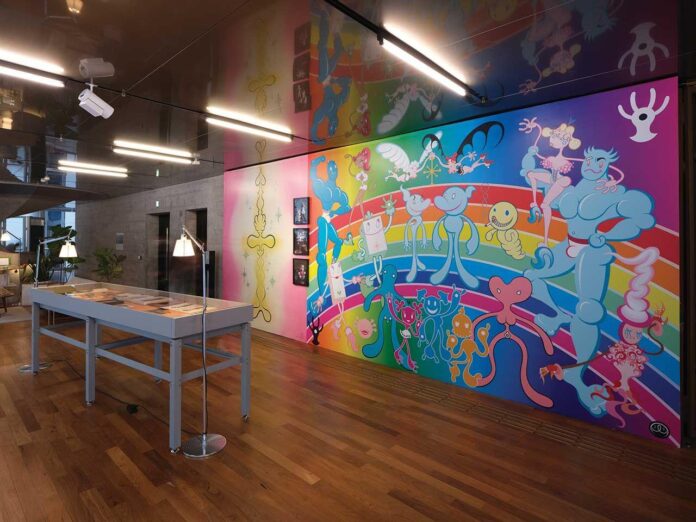Billed as “the first major survey exhibition on LGBTQ+ perspectives in Hong Kong”, Myth Makers—Spectrosynthesis III tests the current waters for free speech in a fast-changing city. Held at Tai Kwun Contemporary (until 10 April), it is the third installment of the Sunpride Foundation’s Spectrosynthesis exhibition series on LGBTQ+ Asian art.
Though censorship has been ramping up in Hong Kong, only one work has been removed from the show. A video from Shu Lea Cheang’s series 3x3x6, depicting ten stories of jailed sexual non-conformists, is replaced in the exhibition by a document of rejection, purportedly for explicit sexual content. Cheang’s piece was originally created for the 2019 Venice Biennale and shown in the Palazzo delle Prigioni, which, like Tai Kwun, is a former prison. The Art Newspaper also understands that a participating Indian artist consented to altering a work.
Hong Kong’s art world is rightly nervous about “mainlandisation” though. While China’s art community has a large, mostly accepted LGBTQ+ contingent, many artists remain publicly closeted, and international queer artists get “straightwashed” for their China exhibitions. However, Hong Kong remains comparatively freewheeling. The show has received “tremendous community support” and public interest since its late December opening, says the Hong Kong businessman Patrick Sun, who established Sunpride in 2014 to collect and promote LGBTQ+ Asian art.
The show begins and ends with video pieces by Ellen Pau, active in Hong Kong’s then nascent art scene since the 1980s. The opening work, Song of the Goddess (1992), depicts “the intimate relationship on and off screen between the [opera] actresses Yam Kim-fai and Pak Suet-sin in the 1960s”, say the exhibition’s curators, Chantal Wong and Inti Guerrero. It is “one of Hong Kong’s earlier examples where viewers collectively accepted identification with a same-sex love story”, they add, with broadcast Cantonese Opera featuring cross-dressing female actors as “the main field in which queerness was manifested culturally and publicly (albeit partially unacknowledged)”.
Concluding the show is Pau’s ethereal new video 52Hz (2022), an oblique tribute to two Hong Kong schoolgirls who died by suicide after their relationship was discovered. Pau’s bookend videos highlight the exhibition’s multi-generational inclusion of historical works, a reminder that LGBTQ+ Asian art is no recent phenomenon.
The first section, “Queer Mythologies: On and Off the Stage”, also includes historical standouts like the late Filipino -US artist Alfonso Ossorio and Bhupen Khakhar of India, while the second section, “Body Politics: Criminalisation, Control and Counter Narratives”, includes Josef Ng’s seminal 1994 performance Brother Cane, after which Singapore banned performance art for a decade due to the artist’s scattering of pubic hair trimmings.
Spectrosynthesis’s 2017 debut at the Museum of Contemporary Art Taipei was the first major survey in a mainstream institution in Asia, providing LGBTQ+ artists with overdue recognition.
Crucially, gay artists in most of Asia still walk a cautious line; Shanghai’s long-running Pride festival ended amid official harassment, while Singapore’s recent decriminalisation of gay sex was coupled with explicit prohibition of gay marriage. Against this turmoil, the Spectrosynthesis series has helped to normalise queerness as a topic in the regional art scene and boosted the visibility of marginalised artists.
Continued expansion
The 2017 exhibition in Taipei, held two years before the island legalised same-sex marriage, featured more than 50 works by 22 ethnic Chinese artists. Spectrosynthesis II was held in 2019-20 at Bangkok Art and Culture Centre, with work by more than 50 artists. In Hong Kong, it expands to 130 works by around 60 artists.
A quarter of participating artists are based in Hong Kong including Trevor Yeung and Beatrix Pang. Queer Reads Library, a non-profit created in 2018, collaborated on an archival section. Jiaming Liao’s photos of the Kowloon Park cruising spot and Samson Young’s sound installation recreating the pulsing sounds of club Propaganda tie the exhibition to local gay collective memory.
The exhibition also delves back into the 1940s with “works from and referring to early manifestations of ‘queer before gay’, before these identities took shape, decades before the term LGBTQ+ was coined”, say the curators, such as Patrick Ng Kah Onn’s 1950s self-portraits. A decades-long collection of letters and pictures by iconic local fashion photographers and artists Kary Kwok and Hiram To lends personal poignance.
Patrick Sun anticipates more international visitors this month, with the first Art Basel in Hong Kong since borders reopened. A fourth installment of the exhibition will be held in an as yet undecided Asian city. He cites the repeals of British colonial code 377, criminalising homosexual acts, in 2018 in India and last August in Singapore. “In some countries it may seem impossible now to host an exhibition like Myth Makers, but the world is changing and I remain optimistic for good reasons,” he says.

























